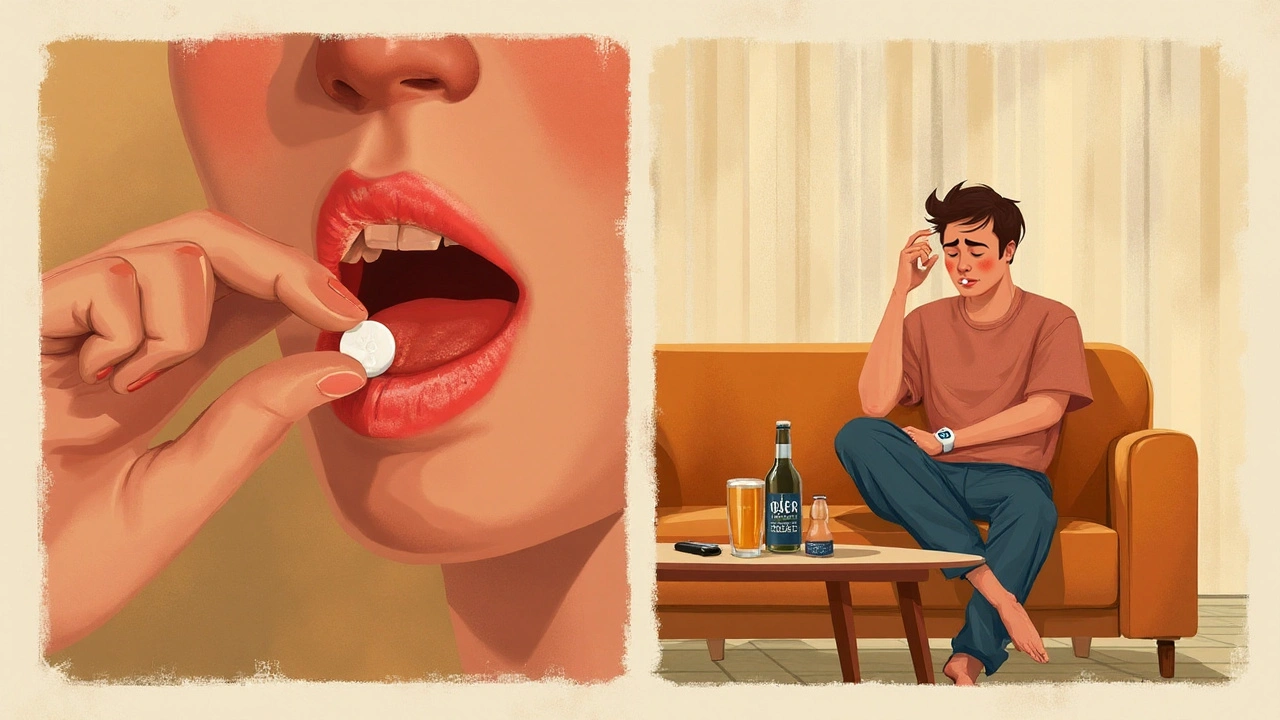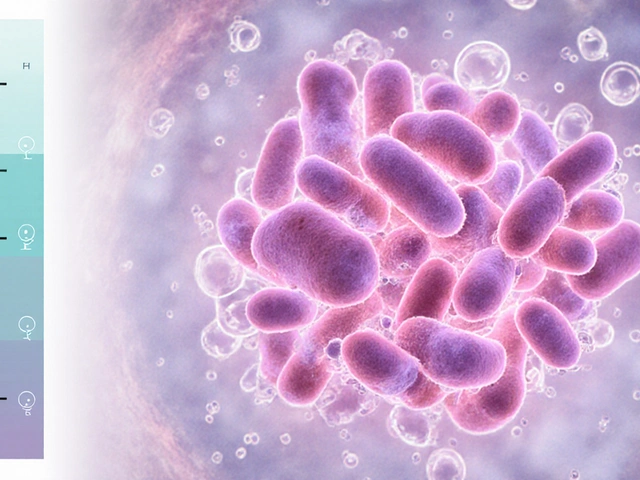Chest pain is terrifying. The right plan, used fast and correctly, can save heart muscle and your life. This guide shows you exactly what nitroglycerin (glyceryl trinitrate, or GTN) does, how to use your spray or tablets step-by-step, the biggest safety traps (hello, erectile dysfunction meds), and when to call emergency services. I’ll keep it plain, practical, and aligned with what cardiology guidelines and New Zealand practice say.
- TL;DR: Nitroglycerin opens blood vessels to quickly ease angina. Use one dose under the tongue, repeat every 5 minutes up to three times if pain continues. If pain is severe or not easing, call emergency services.
- Do not combine with sildenafil, tadalafil, or vardenafil (ED meds), or riociguat-dangerous blood pressure drops happen.
- Sit or lie down before dosing to avoid fainting. Headache is common and a sign it’s working.
- For prevention, patches/long-acting nitrates help-but you still need fast-acting spray/tablets for sudden pain.
- In NZ, brands and pack instructions vary; follow your label plus your doctor’s plan, and check expiry dates regularly.
What nitroglycerin is, how it works, and when to use it
Nitroglycerin (glyceryl trinitrate, often called GTN) relaxes blood vessel walls. That lowers the heart’s workload and improves blood flow to heart muscle. Pain eases because the oxygen supply-demand mismatch shrinks. It doesn’t mask pain like a painkiller; it treats the cause (tight, oxygen-starved myocardium).
What it helps with:
- Fast relief of angina (pressure, tightness, squeezing in the chest). It also helps with coronary artery spasm (Prinzmetal/variant angina).
- Emergency care for suspected heart attack, alongside aspirin and other treatments given by clinicians.
- Prophylaxis: taken before exertion that usually triggers angina (like a steep hill, cold wind, or after a heavy meal).
- Topical (rectal) GTN can treat chronic anal fissure by relaxing the sphincter. Different dose, different aim.
What it does not do:
- It doesn’t fix blocked arteries. It buys time and eases pain while you get proper assessment and treatment.
- It’s not a daily substitute for long-term prevention (statins, stopping smoking, blood pressure control, exercise, weight management).
Common forms you’ll see in New Zealand (brand names may vary):
- GTN sublingual spray (e.g., Nitrolingual Pump Spray 400 micrograms per spray).
- GTN sublingual tablets (less common now; degrade faster once opened).
- GTN transdermal patches (e.g., Nitro-Dur) for prevention, not for acute relief.
- GTN ointment/patch for anal fissures (e.g., Rectogesic) - local effect, not for chest pain.
Onset and duration (typical ranges):
| Form | Use Case | Onset | Duration |
|---|---|---|---|
| Sublingual spray | Acute angina relief | 1-3 minutes | 20-30 minutes |
| Sublingual tablets | Acute angina relief | 1-5 minutes | 20-30 minutes |
| Transdermal patch | Prevention (daytime) | 30-60 minutes | Up to 24 hours (often removed at night) |
| Rectal ointment | Anal fissure | 15-60 minutes | Varies; local effect |
Who should carry fast-acting GTN:
- Anyone diagnosed with angina or coronary artery disease who’s been prescribed it.
- People with coronary vasospasm.
- Some heart failure patients may receive it in clinical settings; at home, follow your specialist’s plan.
Credible sources backing this: NZ Formulary guidance, Medsafe datasheets, and statements from the American Heart Association and European Society of Cardiology. They consistently recommend sublingual GTN as first-line for rapid angina relief and insist on nitrate-free intervals for patches to prevent tolerance.

How to use nitroglycerin: step-by-step, decision-making, and real-life scenarios
First, the two ground rules that save people from avoidable drama:
- Always sit or lie down before dosing. Blood pressure can drop quickly.
- Never mix nitrates with erectile dysfunction drugs (sildenafil, tadalafil, vardenafil) or riociguat. If you took these recently, tell a clinician before taking GTN.
Using a GTN spray (sublingual) for chest pain:
- Stop what you’re doing and rest. Sit or lie down.
- Prime the spray if it’s new (check the label: usually several trial sprays into the air, away from your face). You don’t need to re-prime daily.
- Open your mouth. Bring the nozzle close to your tongue. Hold your breath.
- Press once to deliver one spray under the tongue. Do not inhale. Close your mouth. Do not swallow right away; let it absorb.
- Wait 5 minutes. If the pain is not improving, take a second spray. Repeat once more after another 5 minutes if needed (max three sprays).
- If pain is severe, lasts beyond a few minutes, or feels different (worse, spreading to arm/jaw, clammy, nauseated, breathless), call emergency services. Do not drive yourself.
Using GTN sublingual tablets (if that’s what you have):
- Rest, sit or lie down.
- Place one tablet under the tongue. Do not chew or swallow. Let it dissolve fully.
- Wait 5 minutes. Repeat up to three doses total, 5 minutes apart, if pain persists.
- Tablets degrade once the bottle is opened. Keep the cap tightly closed, store away from heat and moisture, and check the expiry often.
Using a GTN patch for prevention (not for sudden pain):
- Apply to clean, dry, hairless skin on the upper arm or chest. Rotate sites daily to prevent irritation.
- Follow your prescribed dose. A common approach is daytime wear and removal at night to build a nitrate-free interval (about 10-12 hours) that prevents tolerance.
- Remove before MRI and follow instructions for bathing/showering (most patches tolerate brief water exposure).
- Even with a patch, keep your spray/tablets handy for sudden pain.
Decision tree you can remember:
- Typical exertional chest tightness? Stop, rest, take 1 dose under the tongue.
- Better within a few minutes? Great-stay resting another 10-15 minutes before you get up.
- Not better at 5 minutes? Take a second dose.
- Still not better at 10 minutes or symptoms are severe/atypical? Call emergency services and take a third dose if advised while you wait.
Prevention use before exertion:
- If hills or cold wind usually trigger your pain, one spray/tablet 5 minutes before you start can prevent symptoms.
- Warm up slowly. Layer up in cold southerlies. Don’t rush the first few minutes.
Real-life examples:
- Weekend walk up a steep Wellington hill: Take a preventive spray 5 minutes before you head up. If tightness still builds, stop, take another under the tongue, and rest. If it doesn’t ease, it’s not “just the hill” anymore-call for help.
- Heavy meal then chest pressure: GTN may help, but because pain after meals can be trickier, consider this a “lower threshold to call” situation.
- Waking with chest pain at rest: Use GTN right away. Pain at rest deserves urgent assessment.
How much is too much?
- For acute pain, stick to up to three sublingual doses, 5 minutes apart. More doesn’t equal safer or better; it just raises the risk you’ll faint.
- For patches, follow the prescribed micrograms/hour and wear time. Do not cut patches unless the brand instructions allow it.
If a clinician tells you to chew an aspirin while you wait for help and you’re not allergic or at bleeding risk, that’s common practice in suspected heart attack care. If you’re unsure, don’t guess-ask.

Safety, side effects, interactions, storage, FAQs, and your next steps
Common side effects and what to do:
- Headache or throbbing temples: Very common, usually eases with time. Rest in a quiet, dark room. A simple pain reliever your doctor approves is fine unless told otherwise.
- Flushing, warmth, or light-headedness: Sit or lie down until steady. Rise slowly.
- Drop in blood pressure, fainting, or fast heartbeat: This is why you dose while resting. If it’s severe or persistent, seek care.
- Skin irritation from patches: Rotate sites, apply to clean, dry skin, avoid broken skin. If severe, tell your doctor; a different brand or dose may help.
High-risk interactions you must know:
- Erectile dysfunction drugs: sildenafil (Viagra), tadalafil (Cialis), vardenafil (Levitra) - absolute no with nitrates due to dangerous blood pressure drops. Tadalafil lasts long; time gaps are longer. If you’ve taken one recently, speak to a clinician before using GTN.
- Riociguat (for pulmonary hypertension): also contraindicated.
- Alcohol: amplifies blood pressure drop; avoid around dosing.
- Other blood pressure meds: can combine to lower pressure more. Not forbidden, just be cautious and follow your plan.
- Ergot drugs (older migraine meds): can counteract nitrates. Flag this if you use any.
Who needs extra caution:
- Very low blood pressure or volume depletion (vomiting, diarrhea, dehydration).
- Severe anemia.
- Recent head injury or raised intracranial pressure.
- Right-sided (inferior) heart attack - nitrates may worsen blood pressure; this is a clinician decision.
- Pregnancy/breastfeeding: topical fissure treatment sometimes used; systemic use is specialist-guided. Always check.
Storage and shelf-life tips:
- Keep spray canisters at room temperature, away from heat/flames. Do not puncture or burn.
- Do not leave in a hot car or in direct sun at the beach or on a dashboard.
- Keep within reach (jacket, small bag, bedside), but away from curious kids.
- Check the expiry date. Sprays generally last to the printed expiry. Tablets degrade faster once opened; keep tightly capped in the original bottle and replace promptly if crumbling or past expiry.
- Know how many sprays your bottle contains; when it’s nearly out, order a replacement early.
Quick checklists you can screenshot:
Before you use GTN now:
- Am I sitting/lying down?
- Did I avoid ED meds and alcohol?
- Am I using spray/tablet under the tongue, not swallowed?
- Do I know the 5-minute rule and the three-dose max?
What to carry:
- GTN spray/tablets in easy reach
- List of medicines and allergies
- Doctor’s action plan card
- Small bottle of water (to rinse a bitter taste after you’re stable)
Mini-FAQ
- How fast should relief start? Usually within a couple of minutes; full effect by about 5 minutes.
- Can I drive after taking GTN? Not until symptoms are gone and you feel steady. If chest pain needed repeat doses, skip driving.
- How often can I use it in a week? There’s no fixed weekly cap, but repeated episodes mean you need a review. Frequent use can point to unstable angina.
- Is a fierce headache dangerous? Usually not. It’s a common effect. If it’s unbearable or new for you, talk to your doctor; dose or formulation adjustments can help.
- Flights and GTN? Keep it in carry-on with the label. Cabin changes can nudge angina; having it handy is smart.
- Does GTN fix reflux pain? No. Sometimes chest burning is reflux, but don’t self-diagnose during an episode. If in doubt, treat it as cardiac.
- Can I use it before sex? Many people do for exertional angina, but you must not mix with ED meds. Talk to your doctor for a safe plan.
- How do I know if it’s working if pain persists? If there’s no improvement after 2-3 doses, you need urgent medical assessment. Partial relief still requires caution.
Common pitfalls (and how to avoid them):
- Standing while dosing - sit or lie down first.
- Swallowing tablets or spray - they need to absorb under the tongue.
- Waiting too long to seek help - chest pain at rest or not improving needs urgent assessment.
- Using patches but forgetting the nitrate-free interval - leads to tolerance and less effect.
- Keeping tablets in a weekly pillbox - they degrade. Keep them in the original bottle.
Alternatives and add-ons your doctor may discuss:
- Long-acting nitrates (e.g., isosorbide mononitrate) for prevention in stable angina.
- Calcium channel blockers or beta-blockers for symptom control and prevention.
- Statins, antiplatelets, blood pressure control, diabetes management - the big levers that cut events.
- Revascularisation (angioplasty/stent or bypass) if tests show significant blockages.
On its “other life” as an explosive: yes, nitroglycerin is historically used in explosives, but medical GTN is low-dose, metered, and regulated. Do not attempt to make or modify it. Chemistry aside, your role is safe use as prescribed.
Sources I rely on when writing guides like this: NZ Formulary monographs for glyceryl trinitrate; Medsafe datasheets for brands supplied in NZ; American Heart Association statements on chest pain and acute coronary syndromes; 2023 European Society of Cardiology ACS guidance; bpacnz clinical articles on angina management. These all land on the same key points above.
Next steps by scenario
- New to GTN: Practice with your spray (prime safely) so you’re confident. Save this guide and your action plan card together.
- Using GTN weekly (or more): Book a review. You may need preventive meds, dose adjustment, or further testing.
- Frequent or severe headaches from GTN: Ask about dose timing, trialing a different form, or preventive options to reduce use.
- Skin reactions to patches: Rotate sites, ensure skin is fully dry, consider a different brand or a barrier film after medical advice.
- On ED meds: Have an honest chat with your doctor. There are ways to balance heart health and sexual health safely, but timing matters.
- Living alone: Keep GTN within reach in rooms you use most. Set up a check-in system with a friend or family member.
Red flags that mean “seek help now” rather than trying a fourth spray:
- Chest pain at rest that isn’t easing after a couple of doses
- Pain spreading to the arm, jaw, or back, especially with sweating, nausea, or breathlessness
- New, sudden, severe pain that feels different from your usual angina
- Fainting or near-fainting with GTN
Final thought: owning a GTN spray is like carrying a parachute. Learn the steps. Keep it handy. Respect the interactions. And pair it with the day-to-day habits and medical care that actually change your long-term odds. If you’re unsure about anything here, bring your questions to your GP or cardiologist and get a written plan that matches your life.






Written by Martha Elena
I'm a pharmaceutical research writer focused on drug safety and pharmacology. I support formulary and pharmacovigilance teams with literature reviews and real‑world evidence analyses. In my off-hours, I write evidence-based articles on medication use, disease management, and dietary supplements. My goal is to turn complex research into clear, practical insights for everyday readers.
All posts: Martha Elena